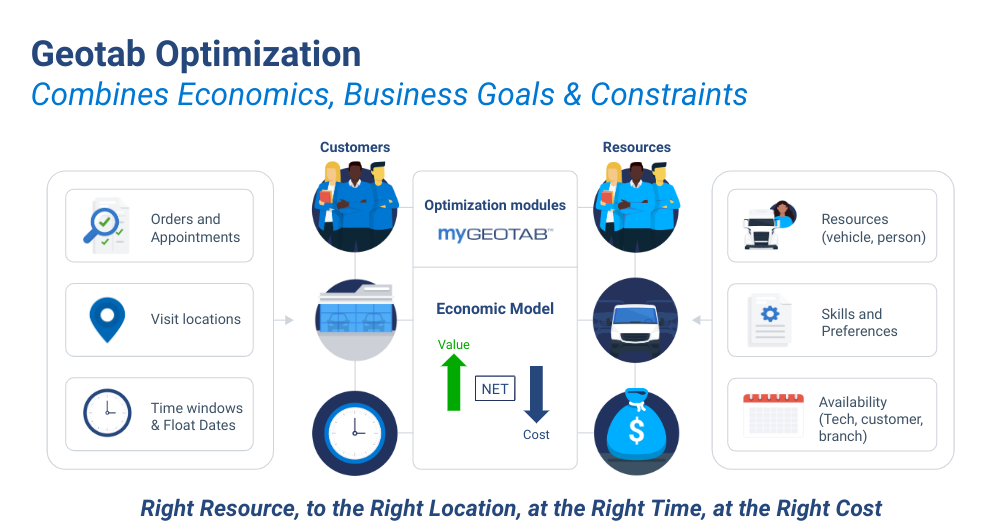Routes to riches – Geotab Routing and Optimization drives operational efficiency and cost management
Geotab's Routing and Optimization software blends economic intelligence with operational strategy, reshaping fleet management for improved cost and resource efficiency.

By Deana Beltsis
Feb 15, 2024
Updated: Jan 2, 2025
5 minute read

Gone are the days when telematics were viewed simply as software for vehicle tracking and safety monitoring. Solutions like Geotab's Routing and Optimization platform have evolved their role, emerging as key assets for business growth. No longer confined to the areas of safety monitoring, these advanced systems now play a critical role in enhancing profitability. This shift has turned what was once seen as a cost center into a strategic contributor, adding value to the bottom line and reshaping how fleet operations can drive overall business success.
Our latest software update reflects a sophisticated blend of operational efficiency and cost management. It refines the way fleet routes are planned and executed, integrating various factors to optimize the impact of each decision on your business. In this blog post, we’ll discuss how this integrated approach offers substantial advantages and the specific benefits it brings to your business.
The real-world challenge
In an ideal world, route planning for fleets would be straightforward – vehicles would travel the shortest distances in the least amount of time, without any external constraints. However, the reality of fleet management is far more complex. Real-world routing is complicated and filled with variables that can change at a moment's notice. Factors such as traffic conditions, customer availability and unexpected delays transform routing into a challenging task that requires flexibility and strategic planning.
The primary objective in this complex environment is to provide exemplary customer service while efficiently managing resources. Achieving this balance helps operators meet customer expectations, respect time commitments and optimize the utilization of vehicles and drivers for peak efficiency.
In this context, simply plotting points on a map is no longer sufficient. Fleet managers need to consider a multitude of factors – from fuel consumption and driver hours to vehicle wear and tear. This is where the ability to adapt to real-world conditions and optimize routes accordingly becomes invaluable.
Geotab’s data-driven approach to routing and optimization
Before looking into the different approaches to fleet routing, it's important to consider the integrated approach that is at the core of Geotab's software. This approach is what makes our solution different. It enables fleet managers to tackle immediate logistical challenges while also considering the economic impact of their decisions.
Decisions utilizing our proprietary AI models extend beyond finding the quickest or shortest routes. They involve a deep analysis of economic factors both hard and soft, such as fuel costs, vehicle maintenance and even the implications of customer satisfaction on long-term business viability. By integrating these considerations into the routing process, decisions become both operationally effective and financially strategic, aligning with a company's broader financial objectives.

Economic insights vs. rules-based optimization
In fleet routing and optimization, there are generally two approaches – a traditional rules-based approach and one that integrates broader economic considerations. Understanding how these differ is important to understanding the advanced capabilities of Geotab's Optimization Model.
Traditional rule-based optimization is a common method that adheres to predefined rules or constraints, such as driver work hours, skill requirements, vehicle capacity, service times and customer appointment windows. The primary aim of this method is to ensure that routes comply with these operational guidelines. While this approach is effective in meeting operational criteria, it may not always result in the most cost-effective or resource-efficient routes, as it tends to overlook the comprehensive balance of both hard and soft costs.
Integrating broader economic considerations is where Geotab’s solution excels. This approach extends beyond operational constraints, incorporating a wider range of economic factors. This includes analyzing aspects such as fuel expenses, vehicle upkeep, staff wages and the potential costs associated with missed or delayed business opportunities. The aim here is to identify routes that are not just operationally feasible but also economically advantageous, finding a balance between cost-effectiveness and high-quality service.
Geotab's Optimization Model merges these broader economic considerations into the routing process. Rather than solely focusing on rule compliance, it enables informed decision-making that takes into account both immediate operational requirements and their longer-term economic impacts. This inclusive approach looks at a wide array of factors, considering direct expenses like fuel and vehicle maintenance, and indirect costs such as driver satisfaction and customer loyalty, to offer a well-rounded view of route optimization. It also allows for modeling optimization scenarios ahead of implementation to understand how changes in staffing, economic goals, and other factors will come to fruition.
Core benefits of economic optimization: The story of a cable provider
To illustrate how Geotab's Routing and Optimization software functions in a real-world scenario, let's consider the day-to-day operations of City Cable, a cable service provider.
Improved route operations
Enhanced visibility with real-time asset location plays an important role at City Cable. Every morning at City Cable, the day begins with route planning. The fleet manager opens Geotab's system to view a real-time map of the fleet. On a busy day, when an unexpected service call comes in, this real-time visibility is crucial. The fleet manager can easily redirect the nearest technician to the job for efficient use of time and resources. This agility in response is what keeps City Cable ahead in operational efficiency.
Increased driver satisfaction and reduced fuel costs are also central to City Cable’s use of Geotab’s software. Allowing technicians to take their vehicles home reduces their daily commute, which directly boosts their job satisfaction. In tandem, the Geotab system recommends the safest, most fuel-efficient routes. For example, choosing a route that avoids a recently reported accident site not only contributes to the technician’s safety, but also saves valuable time and helps reduce fuel consumption that would otherwise be wasted in heavy traffic. At the end of the month, these small, daily savings on fuel accumulate, reflecting positively on City Cable's financials.
Cost reduction
At City Cable, reducing costs is a daily mission. Through Geotab’s efficient routing, their vehicles undergo less strain, translating to fewer maintenance needs and lower expenses. The system's knack for optimal vehicle usage means every resource is utilized, cutting down on costs linked to idle vehicles.
Another important factor is optimizing route validation for cost-effectiveness. When a technician’s schedule suddenly opens up, Geotab’s software enables the fleet manager to quickly adjust by suggesting new, economical routes. This adaptability is key in maintaining operational efficiency while keeping expenses in check.
City Cable's operations team leverages Geotab's software to model various optimization scenarios, allowing them to align specific types of work with in-house technicians and outsourced contractors based on their organization's economic objectives. This strategic approach optimizes City Cable's operations and contributes to its overall success.
Enhanced customer satisfaction
Enhanced customer satisfaction is a direct result of City Cable's use of Geotab's software. One of the major benefits is reduced travel time for technicians leading to quicker service for customers. This efficient scheduling capability not only shortens the customer’s wait time but also minimizes the time drivers spend waiting at customer locations. Less time spent idling at garages or households means more cost-effective operations and more customers served daily, contributing to an overall increase in customer satisfaction.
Another benefit is the increased number of stops, improving resource utilization. Thanks to intelligent scheduling, City Cable can handle more appointments without the need to expand their fleet. This not only improves their service capacity but also offers greater flexibility in scheduling, accommodating more customer needs efficiently. Servicing more customers within the same amount of time has transformed technicians from cost centers to strategic assets.
.png)
Ensuring Service Level Agreement (SLA) compliance through timely and efficient service deliveries is another area where the software makes a significant impact. Its adaptability to daily changes allows City Cable to consistently meet its SLAs, thereby enhancing their reputation and reliability as a service provider.
From daily operations to strategic insight
As we’ve seen through our City Cable story, Geotab's Routing and Optimization solution can greatly refine your everyday operations. But its impact goes beyond operational efficiency and contributes to broader business growth. Geotab’s software surpasses the traditional role of routing and optimization technology, becoming an important tool for strategic planning and boosting profitability.
To learn more about the power of enhanced routing and optimization or to schedule a demo, explore our Fleet Routing and Optimization page.
Subscribe to get industry tips and insights

Deana Beltsis
.
Table of Contents
Subscribe to get industry tips and insights
Related posts

Unlocking Safer Roads: How Behavioral Science and Technology Are Improving Driver Safety
April 14, 2025
2 minute read

What is government fleet management software and how is it used?
April 10, 2025
3 minute read

How a well-built fleet safety culture prevents legal trouble
March 28, 2025
5 minute read

How AI-based in-cab video can lower fleet insurance costs and improve safety
March 24, 2025
3 minute read

